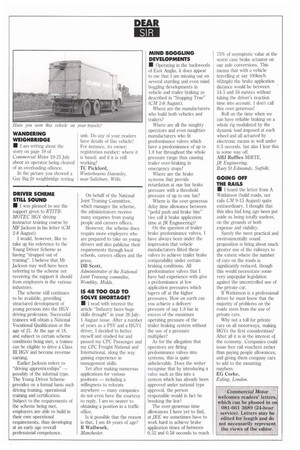MIND BOGGLING D EVELOPMENTS • Operating in the backwoods of
Page 40

If you've noticed an error in this article please click here to report it so we can fix it.
East Anglia, it does appear to me that I am missing out on several startling and even mind boggling developments in vehicle and trailer braking as described in "Stopping True" (CM 2-8 August).
Where are the manufacturers who build both vehicles and trailers?
Where are all the naughty operators and even naughtier manufacturers who fit predominance valves which have a predominance of up to 1.8 bar throughout the whole pressure range thus causing trailer over-braking in emergency stops?
Where are the brake systems that provide retardation at one bar brake pressure with a threshold pressure of up to one bar?
Where is the over-generous delay time allowance between "pedal push and brake bite" (we call it brake application time at JR Engineering)?
On the question of trailer brake predominance valves, I have always been under the impression that vehicle manufacturers fitted these valves to achieve trailer brake compatability under certain braking conditions. All predominance valves that I have had experience with give a predominance at low application pressures which tapers off at the higher pressures. How on earth can you achieve a delivery pressure of say 1.8 bar in excess of the maximum operating pressure of the trailer braking system without the use of a pressure multiplier?
As for the allegation that operators are fitting predominance valves into systems, this is quite unbelievable. Does the writer recognise that by introducing a valve such as this into a system which has already been approved under national type approval, the person responsible would in fact be breaking the law?
The over-generous time allowances I have yet to find, at IRE we sometimes have to work hard to achieve brake application times of between 0.52 and 0.58 seconds to reach 75% of asymptotic value at the worst case brake actuator on our axle conversions. This means that with a vehicle travelling at say 100km/h (62mph) the brake application distance would be between 14.5 and 16 metres without taking the driver's reaction time into account. I don't call this over-generous!
Roll on the time when we can have reliable braking on a whole rig modulated by the dynamic load imposed at each wheel and all actuated by electronic means in well under 0.5 seconds, but alas I fear this is some way off.
AH.1 Ruffles MIRTE,
JR Engineering, Buy St Edmunds, Suffolk.
GOING OFF THE RAILS • I found the letter from A atkinson (build roads, not rails CM 9-15 August) quite extraordinary. I thought that this idea had long ago been put aside as being totally useless, on the grounds of both expense and viability.
Surely the most practical and environmentally sound proposition is bring about much greater use of the railways to the extent where the number of cars on the roads is significantly reduced, though this would necessitate some very unpopular legislation against the uncontrolled use of the private car.
If Watkinson is a professional driver he must know that the majority of problems on the roads stem from the use of private cars.
Why not a toll for private cars on all motorways, making HGVs the first consideration? After all it is in the interest of the economy. Companies could issue free rail vouchers rather than paying people allowances, and giving them company cars to add to the mounting mayhem.
EG Corke, Ealing, London.
















































































